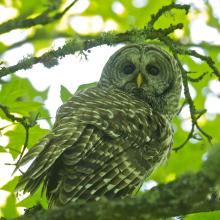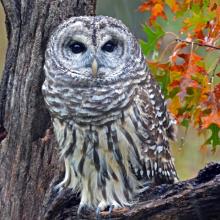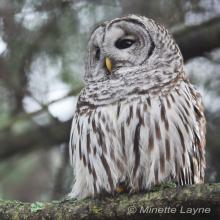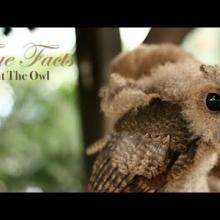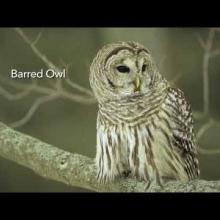

Join BirdNote tomorrow, November 30th!
Illustrator David Sibley and actor H. Jon Benjamin will face off in the bird illustration battle of the century during BirdNote's Year-end Celebration and Auction!
The emphatic hoots of a pair of Barred Owls resonate in the still of a winter's night. Like many owls, Barred Owls initiate their vocal courtship in winter. And they're among the most vocal. These owls have more than a dozen calls, ranging from a "siren call" to a "wail" to a wonderfully entertaining "monkey call." Barred Owls are among the largest owls in North America.
BirdNote®
Here Come the Barred Owls
Written by Bob Sundstrom
Mary McCann: This is BirdNote.
[Typical hoot sequence of a pair of Barred Owls]
The emphatic hoots of a pair of Barred Owls resonate in the still of a February night. So-called for the stripes on their breast, Barred Owls are among the largest owls in North America. They're also the most vocal. Their signature hooting sequence has been memorably described as “who-cooks-for-you?! who-cooks-for-you-all?!”
[Typical hoot sequence of a pair of Barred Owls]
But this is just one of more than a dozen Barred Owl calls, ranging from a “siren call” to a “wail” to a wonderfully entertaining “monkey call.”
[Barred Owl monkey call]
Although the Barred Owl’s calls have long been heard in Eastern forests, it is a relative newcomer to the western US. During the 20th Century, its breeding range has expanded into the North and the West, and down as far as northern California.
The exact reasons behind the expansion aren't certain. But new riparian forests, fire suppression, and the planting of shelter-belts in the northern Great Plains are some of the human impacts that have likely played a role.
No matter what accounts for the Barred Owl’s dramatic sweep across the continent, the bird – and its extraordinary voice – seem here to stay.
[Barred Owl “monkey call”]
For BirdNote, I'm Mary McCann.
###
Call of the Barred Owl provided by The Macaulay Library of Natural Sounds at the Cornell Lab of Orni-thology, Ithaca, New York. Barred Owl [105433] recorded by G.A. Keller
BirdNote's theme music was composed and played by Nancy Rumbel and John Kessler
Producer: John Kessler
Executive Producer: Dominic Black
© 2015 Tune In to Nature.org February 2017/2019/2021/2024
Narrator: Mary McCann
ID# 022607BADO2 BADO-01b




